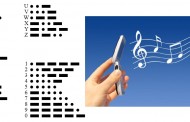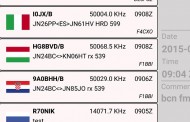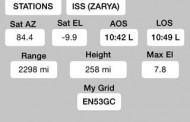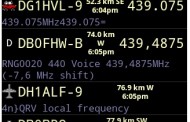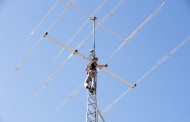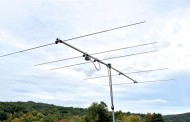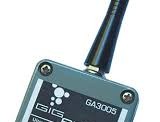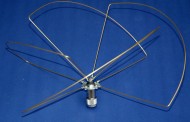Photo:ARISS 25 watt JVC-Kenwood D710GA at Hamvention 2017 – Credit John Brier KG4AKV
The ARISS website reports on progress towards flying new amateur radio equipment to the International Space Station.
On behalf of the ARISS International team, I am proud to announce that on Friday September 29th the ARISS team submitted the InterOperable Radio System (IORS) Safety Data Package to NASA for review! Our next step in this process is the Safety Review, which is planned for November 2.
Submitting this was a phenomenal accomplishment!! Particularly since the entire Safety Data Package was developed exclusively by our ARISS volunteers—something we have never done before. Prior to this submittal, all safety packages—from Owen Garriott’s in the early 1980s to today–were developed with contractors from NASA, ESA or Energia. And might I say at substantial expense. I am pleased that the ARISS team did it ourselves!
A
Why is this important? Two reasons:
1) This is a very major IORS milestone. We cannot get to orbit without successfully completing the safety review process and getting our hardware certified for flight.
2) Developing the safety package exclusively with volunteers is an innovative and gutsy approach to keep costs down and get the hardware flown sooner. Otherwise we probably would have to slip launch 1-2 years while we acquired additional funding to get this done.
NASA Human Spaceflight Safety Certification is a four-step process—Phase 0, Phase 1, Phase 2 and Phase 3. The material we submitted covers the first three of the four phases. As part of Phases 0, 1 and 2, we need to make sure NASA understands our design. And we need to show NASA that we understand all the potential hazards that our hardware systems could introduce to ISS and how we have mitigated (or prevented) these hazards. One example is to demonstrate to NASA that our IORS was designed with electrical wiring and circuit breakers that possess adequate features and sufficient margin to prevent an electrical shock or fire on-board the ISS. Critically important stuff! The final phase (Phase 3) will be complete when we have completed all testing and NASA inspection of our flight hardware and NASA deems it flight worthy. At that point the IORS will be flight certificated and we can fly! Currently we are looking to March-May 2018 for flight readiness.
For those not following ARISS hardware development very closely, we are developing the IORS to replace most of the on-board radio hardware. It is called “interoperable” because it is being designed to be operated anywhere on ISS. But specifically, it will be used in the two areas with ISS Ham legacy antennas: the Columbus Module and the Russian Service Module. Interoperability allows us to leverage existing ISS power cables, it can be moved between modules in the event of on-orbit failures, and it supports common training and operations.
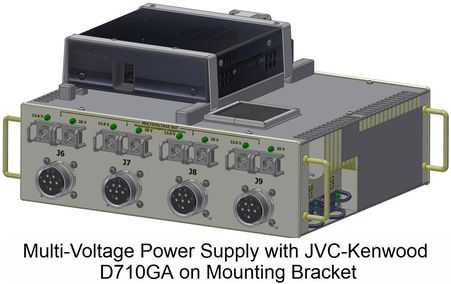 cabin hardware system we have ever designed, built, tested and flown as a volunteer team. We will remove the 3 watt Ericsson handheld radio system, initially certified for flight in 1999, and the Packet module–both of which have recently had issues—and install a brand-new, specially modified 25 watt JVC Kenwood D710GA radio to enable a multitude of new or improved capabilities on ISS, including voice repeater and better APRS operations. A key development is the Multi-Voltage Power Supply (MVPS), which interfaces with multiple electric outlet connection types on ISS and provides a multitude of power output capabilities for our current and future ARISS operations and amateur radio experimentation. It will also allow our Ham Video system to have a dedicated power outlet, eliminating the outlet sharing we have now, which shuts down Ham Video at times.
cabin hardware system we have ever designed, built, tested and flown as a volunteer team. We will remove the 3 watt Ericsson handheld radio system, initially certified for flight in 1999, and the Packet module–both of which have recently had issues—and install a brand-new, specially modified 25 watt JVC Kenwood D710GA radio to enable a multitude of new or improved capabilities on ISS, including voice repeater and better APRS operations. A key development is the Multi-Voltage Power Supply (MVPS), which interfaces with multiple electric outlet connection types on ISS and provides a multitude of power output capabilities for our current and future ARISS operations and amateur radio experimentation. It will also allow our Ham Video system to have a dedicated power outlet, eliminating the outlet sharing we have now, which shuts down Ham Video at times.
This effort would not be possible without the dedication and persistence of our IORS development team of volunteers. They have been working tirelessly behind the scenes to provide an outstanding amateur radio experience for all. Our IORS development team includes: Lou McFadin, W5DID, our Chief Engineer; Kerry Banke, N6IZW, the MVPS lead designer; Bob Davis, KF4KSS, the MVPS Mechanical enclosure designer; Ed Krome, K9EK, supporting IORS thermal control and cabin noise dissipation; Dave Taylor, W8AAS, our JVC Kenwood D-710 development liaison; Bob Bruninga, WB4APR, our APRS and D-710 operations expert; Shin Aota, JL1IBD, and Phil Parton, N4DRO for all their phenomenal support from JVC Kenwood; Kenneth Ransom, N5VHO, our operations lead; and our safety package team—Ken Ernandes, N2WWD, and Gordon Scannell, KD8COJ. Kudos to all on a fantastic effort!
Designing, building and testing the IORS is a huge undertaking and *very* expensive. We need to build ten (10!) units to support flight hardware, flight spares, testing, and training across the international team. Hardware parts, development tools, fabrication, testing, and expenses to certify the IORS are expected to cost approximately $150,000. And the hard part (i.e. most expensive part) is just now starting. So please consider making a donation to ARISS to take our hardware system from dream to reality. You can donate to ARISS directly through the AMSAT web site at: http://www.ariss.org/donate.html. ALL donations go directly to ARISS.
Thank you for all your support to inspire, engage and educate our youth to consider wireless communications and amateur radio, and to pursue STEAM careers through our exciting human space exploration and amateur radio endeavor!
Ad Astra! To the Stars!
Sincerely,
Frank H. Bauer, KA3HDO
ARISS International Chair and ISS Ham Radio Principal Investigator
Source http://ariss.org/ via AMSAT UK
Equipment
The ZN-HKR is new for 2015 by N3ZN
The ZN-HKR is new for 2015. It is an all brass straight key built on a 4″ diameter brass base. It features 4 ball bearing and silver con… Read more
IC-R30 Communications Receiver [ Video ] HamFair
IC-R30 Communications Receiver (Handheld) The IC-R30 is the successor to the popular IC-R20 compact handheld receiver. The IC-R30 can listen to two si… Read more
How to Build A 130 Watt Dummy Load for HF Ham Radio
In this video I go through the building of a paint can dummy load that a ham radio operator may require for testing and tu… Read more
NEW Alinco DM330FXE 30A Supply with USB ports
Alinco DM-330FXE This CE approved switch mode power supply packs a lot of features into a compact, lightweight design that boasts a 9-15VDC variable… Read more
Review
The Xiegu X5105 : QRP Portable Transceiver
X5105 is a highly portable transceiver working at HF+6m band, with a built-in power output of 5W. Technical features: double-conversion superheterody… Read more
Ameritron ALS-500M Amp and MFJ-4275MV Power Supply
Ameritron mobile no tune Solid State Amplifier –Mobile no tune Solid State Amplifier – uses four rugged 2SC2879 high power linear RF power… Read more
Yaesu FT 891 Install And First Contact
“If you are thinking of adding a new radio to your shack or mobile check out this video on the new Yaesu FT-891! It is my opinion that you can… Read more
App – Mobile
Morse code Ringtone Generator by M1RGZ
“This page converts text into a morse code ringtone playable on most mobile phones. If your phone can play ‘polyphonic’ or ‘po… Read more
NKCCluster 2.1 to be released very soon
A new NKCCluster release is just around the corner: release 2.1 is currently undergoing beta-testing and, provided no last minute surprises i.e. major… Read more
Satellite Explorer Pro – IOS App
‘Satellite Explorer Pro’ is a tool for tracking satellites in real time. It is not a game. Be sure to visit the support web site http://ww… Read more
APRSdroid – APRS for Android
What is APRSdroid? APRSdroid is an Android application for Amateur Radio operators. It allows reporting your position to the APRS (Autom… Read more
Antenna
Lesson 6.1 Antenna Basics
Antenna Basics “General Class Ham Radio instructional video, introduces Section 6.1 in the ARRL General Class License Manual. The section is ext… Read more
JK Antennas JK65 6 Meter Yagi
6 Meter Yagi Want to be heard on 6? JK Antennas JK65 6-Meter Yagi Antennas give you tremendous VHF performance with very high gain on a… Read more
GigActiv GA3005 Ultra Wideband
GigActiv GA3005 Ultra Wideband Frequenzy range : 9 kHz – 3 GHz Power Supply: 5,5V – 15V Gain: + 3dB Upper Frequency Limit (-1db): 3000 MHz… Read more
Skew Planar Wheel Antenna for 435MHz
Antenna for 435MHz Skew-Planar antenna has had little attention in the amateur radio community despite being present in QST by Robert H…. Read more


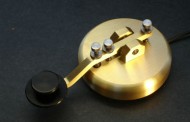
![IC-R30 Communications Receiver [ Video ] HamFair](http://www.iz4wnp.it/wp-content/uploads/2017/10/ic30-190x122.jpg)
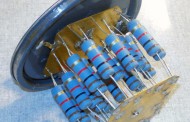
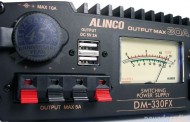
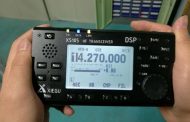
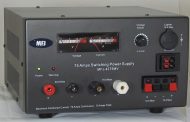
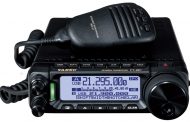
![SDR Transceiver MB1 [ Videos ]](http://www.iz4wnp.it/wp-content/uploads/2017/10/MB1_1-1024-190x122.jpg)
